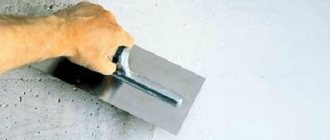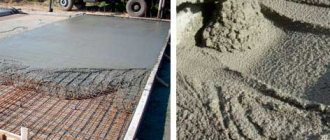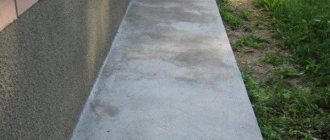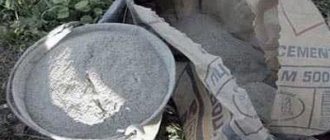The proportions of cement for different types of mortars will be of interest primarily to non-professional developers and repairmen. Professional builders, as a rule, prepare concrete solutions “by eye”, and most often order their delivery to the nearest concrete plant.
Private developers often prefer to save on “anything and everything,” so the proportions of cement in mortars for various purposes will be useful primarily for those who prepare concrete building materials on their own.
Main types of mortars
Depending on the purpose, cement-based mortars are divided into the following widely used types:
- Heavy concrete of different grades.
- Masonry mortars.
- Plaster solutions.
- Solutions for the construction of floor screeds.
- Repair solutions.
The listed different building materials have one common factor - all of the listed building materials contain cement, which is a “binder” that has no analogues.
Considering that readers of the article will find practical information of the following order useful: the proportions of sand and cement for screed, the proportions of sand and cement for concrete, the proportions of cement for screed, the proportions of cement for masonry, as well as the ratio of sand and cement for plaster, we will consider it step by step, indicating specific numbers.
The ratio of sand and cement for floor screed
Floor screed can be used as a basis for laying a finished floor made of boards, plywood, laminate, parquet, solid boards, USB boards, ceramic tiles, mosaics, porcelain tiles and soft materials (carpet, linoleum, carpet runners and rugs).
Floor screed is also used as a “finish” floor covering in utility buildings and rooms with high humidity: bathrooms, bathrooms, saunas, baths and kitchens.
On the Internet and in private conversations, you can read and hear a variety of options on how to properly mix cement with sand in proportions for floor screed. At the same time, there are practical rules and proportions for preparing the solution that can be applied to the vast majority of cases.
For 99% of screed options, it is recommended to use a cement-sand mortar of grade M150 or M200 based on the most affordable cement grade TsEM I 42.5N PTs or TsEM I 52.5N PTs. The outdated designations of these brands of parliaments are M400 and M500.
The ratio of cement and sand for the floor can be seen in the table:
| Brand of solution | M400 cement proportion | Sand proportion | Solder proportions |
| M150 | 1 | 3,0 | 1,3 |
| M200 | 1 | 2,5 | 1,0 |
| Brand of solution | M500 cement proportion | Sand proportion | Solder proportions |
| M150 | 1 | 4,0 | 1,3 |
| M200 | 1 | 3 | 1,0 |
Application area
Due to its properties and technical characteristics, the M200 concrete grade has found wide application in construction. With its help, problems of varying levels of complexity are solved, because it is distinguished not only by good quality, but also by an affordable price.
Manufactured concrete M200 with strength class B15 is very often used as a foundation for houses, monolithic walls, ceilings, flights of stairs or reinforced concrete structures. Other areas of application include:
- creation of concrete paths;
- concreting roadside slopes, curbs and embankment fences;
- creation of concrete screed in open areas and indoors;
- construction of load-bearing walls or production of floors;
- production of concrete rings for wells for various purposes or fences;
- production of road slabs using special additives;
- concrete repair and strengthening of building structures.
Do not forget that it is better not to use M200 concrete for buildings and structures subject to high loads.
When determining the area of destination of the material, it is worth taking into account the crushed stone fractions. Fractions of small diameter are used in small formworks, since the solution in this case spreads smoothly throughout the entire form and allows you to obtain small structures. The coarse-grained fractions of crushed stone in concrete allow it to be used in the creation of strip foundations and reinforced concrete structures.
Outdoor side table made of concrete
Ratio of cement and sand for concrete
The concept of “concrete” combines a number of different building materials prepared on the basis of different cements and different fillers. Without going into details, it is worth noting that in private construction, in 99.9% of cases, heavy concrete of certain grades is used.
Therefore, information about special types of concrete will be educational, but has no practical significance. Therefore, within the framework of this article, the ratio of the main components of heavy concrete of popular grades, which are widely used in private construction, is given.
The main brands of heavy concrete include the following names: M150, M200, M300 and M400. These are the most popular options, covering 99.9% of the needs of private developers. The following table of the ratio of components that must be used to prepare 1 m3 of solution tells how to prepare the indicated grades of concrete.
| Concrete grade | Cement CEM I 42.5N PC, kg | Sand, kg | Crushed stone, kg | Water, l |
| M150 | 215 | 735 | 1135 | 190 |
| M200 | 255 | 715 | 1125 | |
| M300 | 335 | 670 | 1105 | |
| M400 | 420 | 625 | 1085 |
| Concrete grade | Cement CEM I 52.5N PC, kg | Sand, kg | Crushed stone, kg | Water, l |
| M150 | 190 | 755 | 1135 | 190 |
| M200 | 225 | 735 | 1125 | |
| M300 | 290 | 705 | 1105 | |
| M400 | 355 | 675 | 1085 |
The consumption of components per 1 cubic meter of concrete is a generally accepted norm and generally accepted equivalent. If, according to construction conditions, it is necessary to prepare an amount of concrete less than 1 m3, you can take the material consumption per 1 m3 as 100% and decide the proportion to find out the required value in kg.
For example. It is necessary to mix concrete grade M150 in an amount of 0.3 m3 based on cement M400 1 m3 - 100%, 0.3 m3 - X%. We solve the proportion: 0.3x100/1=30%(0.3). Multiplying the tabulated values of the amount of materials by 0.3, we get: 64.5 kg of cement, 220.5 kg of sand, 340.5 kg of crushed stone and 57 liters of water, required to prepare M150 grade concrete based on M400 cement.
Cement proportions for masonry
In general, mortars for laying brick, foam block, cinder block, shell rock or limestone include the following components: cement CEM I 32.5N PC (M300) or cement CEM I 42.5N PC (M400), fine sand, lime and water.
In this case, lime is added to give strength and “warmth” to masonry joints and is an “optional” component. However, if the developer wants to obtain high quality (strength, durability and thermal insulation) of the masonry, it is worth going to small additional costs and preparing a lime mortar for masonry in accordance with the table of the number of components per 1 m3 of masonry mortar:
| Brand of masonry mortar | Cement CEM I 42.5N PC (M400), kg | Sand, kg | Lime, kg | Water, l |
| M50 | 170 | 1445 | 205 | 230 |
| M75 | 235 | 1395 | 165 | |
| M100 | 290 | 1365 | 133 | |
| M150 | 380 | 1305 | 75 |
| Brand of masonry mortar | Cement CEM I 32.5N PC (M300), kg | Sand, kg | Lime, kg | Water, l |
| M50 | 220 | 1410 | 175 | 250 |
| M750 | 305 | 1365 | 125 | |
| M100 | 370 | 1305 | 85 | |
| M150 | 485 | 1235 | 15 |
The ratios of cement and sand given in the table for laying brick, cinder block, foam block, shell rock and limestone, using the “proportions” technology, can be recalculated for volumes of material smaller than 1 m3.
Additives for colored seams
Sometimes construction work must, in addition to the main one, also have an aesthetic, decorative result. This is where color additives come to the rescue. Their palette is extensive and they have the following features:
- the ability to improve appearance, avoid gray color;
- the ability to maintain a single style with a building, a house;
- does not affect the mixing technology, does not add difficulties to the work;
- it is possible to make a solution at home;
- resistance to external factors ensures the durability of the color coating.
If you need to make a solution of a bright color, then it is better to use white cement instead of gray.
How to make seams white
White color can emphasize the texture and volume of structures. Therefore, it is often used during masonry to give expressiveness to the building.











